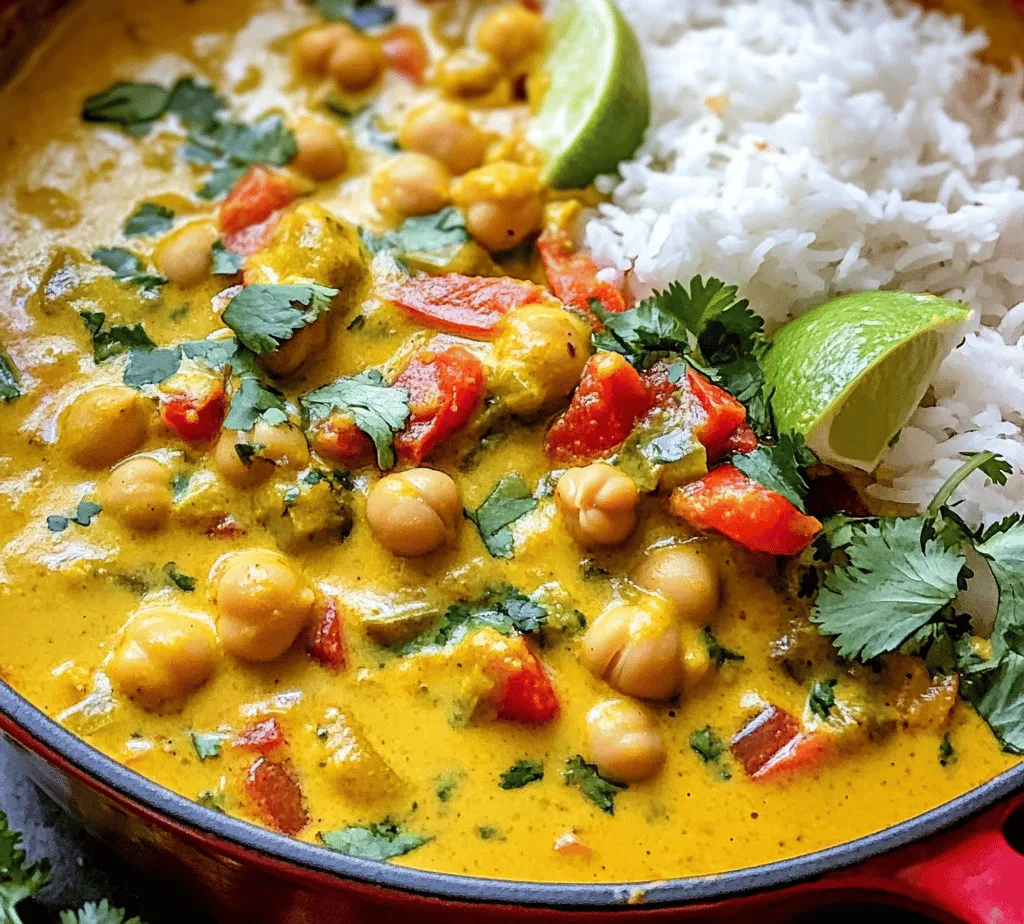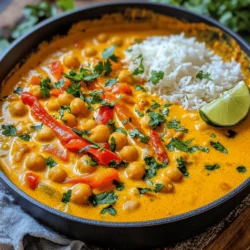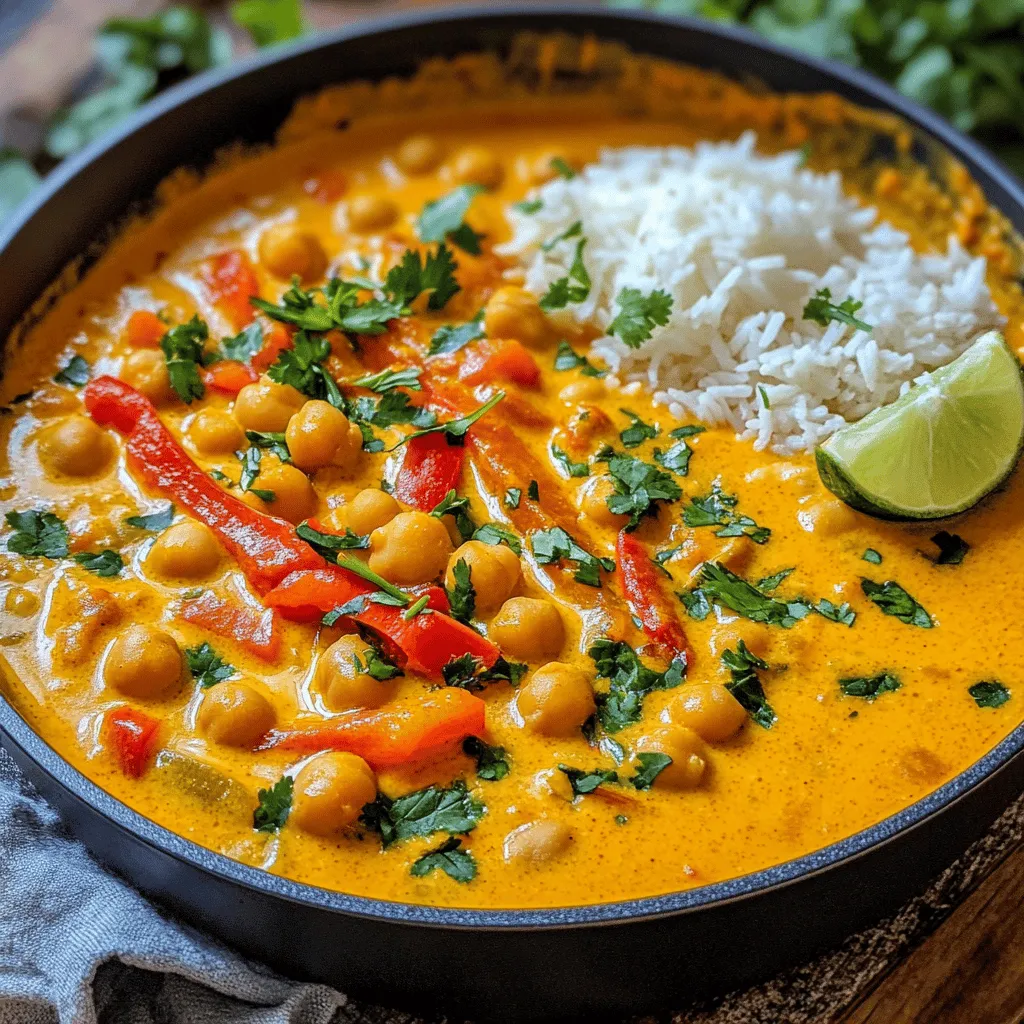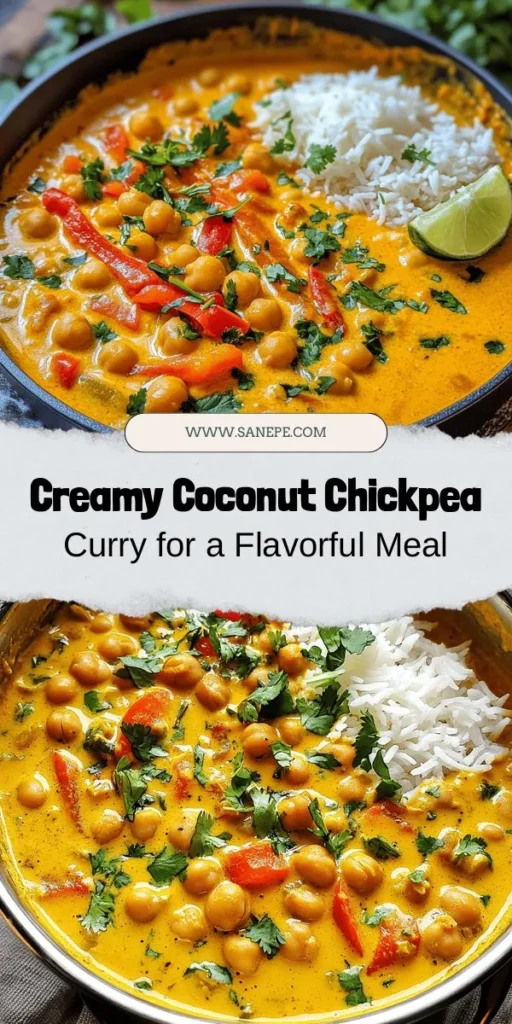In the realm of comforting and nutritious meals, creamy coconut chickpea curry stands out as a vibrant dish that tantalizes the taste buds while being incredibly simple to prepare. This delightful curry is not only rich in flavor but also packed with protein and essential nutrients, making it an excellent choice for both vegetarians and meat lovers alike. Originating from the diverse culinary traditions of Asia and the Middle East, this dish brings together the earthy flavors of chickpeas, the creamy texture of coconut milk, and an array of aromatic spices that create a symphony of taste in every bite.
The appeal of creamy coconut chickpea curry lies not just in its deliciousness, but also in its versatility. Whether served over a bed of fluffy rice, alongside warm naan, or even as a standalone dish, it offers a satisfying meal that can be enjoyed any day of the week. In this article, we will delve into the origins, health benefits, and the step-by-step process to create this scrumptious dish, ensuring you have all the knowledge and inspiration you need to bring this recipe into your kitchen.
Understanding Chickpeas: The Star Ingredient
The Nutritional Powerhouse of Chickpeas
Chickpeas, also known as garbanzo beans, are a staple in many cuisines around the world. Their nutty flavor and grainy texture pair well with a variety of other foods and ingredients. More importantly, chickpeas are rich in protein, fiber, and essential vitamins and minerals, making them a popular choice for healthy eating.
Incorporating chickpeas into your diet can yield numerous health benefits. For starters, their high fiber content aids in digestion and helps maintain a healthy gut. This can reduce the risk of digestive disorders and promote regular bowel movements. Moreover, chickpeas are known to support heart health by helping to lower cholesterol levels, thereby reducing the risk of heart disease. They also provide a good source of plant-based protein, making them an excellent dietary choice for vegetarians and vegans looking to meet their protein requirements.
Chickpeas are also low on the glycemic index, which means they have a minimal impact on blood sugar levels. This feature makes them a great option for those managing diabetes or those looking to maintain stable energy levels throughout the day. Additionally, chickpeas are rich in essential minerals such as iron, magnesium, and manganese, all of which play vital roles in various bodily functions.
The Versatility of Chickpeas in Cooking
Chickpeas can be used in a variety of dishes beyond curries, such as salads, soups, and snacks. Their versatility is one of the reasons they have gained popularity in kitchens worldwide. You can enjoy chickpeas in their whole form, blended into a dip like hummus, or ground into flour for baking.
In salads, chickpeas add a hearty element that makes them filling and nutritious. They can be tossed into green salads, grain bowls, or even blended into a creamy dressing. When roasted, chickpeas become a crunchy snack that can be seasoned with spices for an extra kick. Furthermore, chickpeas can be incorporated into soups and stews, providing texture and protein to the dish without the need for meat.
This adaptability extends to their flavor profile as well. Chickpeas absorb the flavors of the ingredients they are cooked with, making them an excellent canvas for various spices and herbs. Whether you are preparing a Mediterranean dish, an Indian curry, or a Middle Eastern mezze platter, chickpeas can elevate your culinary creations.
Coconut Milk: A Creamy Delight
The Health Benefits of Coconut Milk
Coconut milk not only adds a creamy texture to dishes but is also rich in healthy fats, vitamins, and minerals. It is made from the flesh of mature coconuts and is often used in both sweet and savory dishes. One of the key health benefits of coconut milk is its content of medium-chain triglycerides (MCTs), which are known to boost energy and support weight management. MCTs are metabolized differently than other fats, making them a quick source of energy that can be utilized by the body more efficiently.
Additionally, coconut milk is a good source of vitamins C, E, B vitamins, and minerals like magnesium and potassium. These nutrients contribute to overall health by supporting immune function, promoting skin health, and aiding in muscle contractions and nerve function. Moreover, coconut milk has been linked to improved heart health due to its ability to lower bad cholesterol levels while raising good cholesterol levels.
Using Coconut Milk in Cooking
Coconut milk is a versatile ingredient that can be used in both savory and sweet dishes. In savory cooking, it lends a rich and creamy texture to soups, stews, curries, and sauces. When used in desserts, coconut milk adds a subtle sweetness and a unique flavor that pairs well with fruits, chocolate, and spices.
When selecting coconut milk for your recipes, it’s essential to choose high-quality brands that do not contain additives or preservatives. Full-fat coconut milk is often recommended for curries as it provides a luxurious creaminess, while light coconut milk can be used for lighter dishes without sacrificing flavor. Additionally, you can find coconut milk in cartons or cans; canned coconut milk tends to be thicker and creamier, making it a great choice for cooking.
Coconut milk can also be used in smoothies, oatmeal, and baked goods, providing an exotic twist to your everyday recipes. Its creamy texture complements a variety of flavors, making it a favorite among home cooks and professional chefs alike.
The Flavor Profile of the Curry
Understanding the Spices
The flavor profile of creamy coconut chickpea curry is enhanced by a blend of aromatic spices that create depth and complexity in the dish. Commonly used spices include cumin, coriander, turmeric, and garam masala, each contributing its unique characteristics.
Cumin adds a warm, earthy flavor that serves as a foundation for many Indian dishes. Coriander brings a citrusy, slightly sweet note that brightens the overall flavor. Turmeric, renowned for its vibrant yellow color, not only adds a warm, slightly bitter taste but also offers numerous health benefits due to its anti-inflammatory properties. Garam masala, a blend of ground spices, brings warmth and sweetness, making it a perfect finishing touch for curries.
Fresh ingredients such as ginger and garlic are also essential to the flavor profile of this curry. Ginger adds a zesty heat, while garlic imparts a savory depth that complements the sweetness of the coconut milk. Together, these ingredients create a harmonious balance that elevates the dish.
As we move forward, we will explore the step-by-step process of creating this delicious creamy coconut chickpea curry, ensuring that you have all the information needed to recreate this delightful dish in your own kitchen. Stay tuned for the detailed instructions that will guide you through every stage of the cooking process, from gathering ingredients to savoring the final result.

The Unique Qualities of Spices in Creamy Coconut Chickpea Curry
The creamy coconut chickpea curry is a symphony of flavors, harmonized by a vibrant blend of spices. Each spice contributes a unique quality that elevates the overall dish, making it not only delicious but also aromatic and intriguing.
Curry Powder
Curry powder is a quintessential spice mix that varies in composition but typically includes turmeric, coriander, cumin, and fenugreek. It adds warmth and depth to the curry, creating a foundation of flavor that is both comforting and complex.
Turmeric
Known for its vibrant yellow color, turmeric is not only a flavor enhancer but also offers numerous health benefits. Its earthy and slightly bitter taste complements the sweetness of the coconut milk, resulting in a well-rounded flavor profile. Additionally, turmeric is packed with antioxidants and anti-inflammatory properties, making this dish as nutritious as it is delicious.
Cumin
Cumin has a warm, nutty flavor that brings a distinctive earthiness to the curry. It is often used in Indian cuisine and pairs beautifully with the creaminess of coconut milk. Cumin also aids digestion, adding to the overall health benefits of the dish.
Paprika
Paprika adds a subtle sweetness and a smoky undertone, depending on the variety used. It enhances the color of the curry, making it visually appealing while contributing to a slightly spicy kick. The heat level can be adjusted based on personal preference, allowing customization for those who enjoy a milder or more zesty flavor.
Together, these spices create a rich tapestry of flavors that make the creamy coconut chickpea curry not only satisfying but also intriguing to the palate.
Balancing Flavors: Sweet, Savory, and Spicy
Successfully balancing the flavors in creamy coconut chickpea curry is essential to achieving a perfect dish. The interplay of sweet, savory, and spicy elements creates a delightful experience that keeps you coming back for more.
Seasoning
Proper seasoning is crucial in any curry. Start with a base of salt to enhance the natural flavors of the ingredients. Taste as you cook, adjusting the seasoning to achieve the desired flavor profile. A pinch of sugar can also help to round out the flavors, especially if the curry tastes too acidic or bitter.
Lime Juice
Adding lime juice at the end of cooking is a game-changer. The acidity brightens the dish, cutting through the richness of the coconut milk while providing a refreshing contrast. The zesty notes of lime enhance the overall flavor, making each bite more vibrant and lively.
By carefully balancing these components, you can create a dish that is not only satisfying but also memorable, highlighting the unique characteristics of each ingredient.
Step-by-Step Guide to Crafting Creamy Coconut Chickpea Curry
Preparation: Gathering Your Ingredients
Before embarking on your culinary adventure, it’s essential to gather all the necessary ingredients. Here’s a comprehensive list for making creamy coconut chickpea curry:
Main Ingredients:
– 1 can chickpeas (15 oz), drained and rinsed
– 1 can coconut milk (13.5 oz)
– 1 medium onion, finely chopped
– 3 cloves garlic, minced
– 1-inch piece of ginger, minced
– 1 red bell pepper, chopped
– 1 tablespoon curry powder
– 1 teaspoon turmeric
– 1 teaspoon cumin
– 1 teaspoon paprika
– 1 tablespoon vegetable oil (or coconut oil)
– Salt and pepper to taste
– Juice of 1 lime
– Fresh cilantro for garnish
Optional Ingredients:
– 1 cup spinach or kale, chopped
– 1-2 green chilies, finely chopped (for added heat)
– 1 tablespoon soy sauce or tamari (for umami flavor)
– Cooked rice or naan bread for serving
Having everything prepared and within reach will streamline the cooking process, making it enjoyable and efficient.
Cooking Instructions: A Detailed Walkthrough
Now that you have your ingredients ready, let’s dive into the cooking process:
1. Heat the Oil
In a large pot or skillet, heat the vegetable oil over medium heat. Allow it to warm for a minute before adding the onions.
2. Sauté the Aromatics
Add the chopped onions to the pot and sauté until translucent, about 5 minutes. Stir in the minced garlic and ginger, cooking for an additional 1-2 minutes until fragrant.
3. Add the Bell Pepper
Incorporate the chopped red bell pepper, sautéing for another 3-4 minutes until it softens. The vibrant color will enhance the visual appeal of the curry.
4. Stir in the Spices
Add the curry powder, turmeric, cumin, and paprika to the pot. Stir well to coat the vegetables in the spices and cook for about 1 minute, allowing the spices to bloom and release their aromatic oils.
5. Combine Chickpeas and Coconut Milk
Pour in the drained chickpeas and coconut milk, stirring to combine all the ingredients. Bring the mixture to a gentle simmer, allowing it to cook for about 10 minutes. This will help thicken the curry and meld the flavors together.
6. Add Optional Greens
If you’re including spinach or kale, add it to the pot during the last few minutes of cooking. Stir gently until the greens are wilted and incorporated into the curry.
7. Season and Finish
Taste the curry and adjust the seasoning with salt, pepper, and lime juice. Stir well to combine, ensuring a balanced flavor profile.
8. Serve Hot
Once the curry reaches your desired consistency and flavor, remove it from the heat. Let it sit for a few minutes to cool slightly before serving.
Serving Suggestions and Pairings
Perfect Pairings: Rice and Naan
Creamy coconut chickpea curry is incredibly versatile and pairs beautifully with various accompaniments. Here are some popular options:
– Rice
Steamed jasmine or basmati rice is a classic pairing that soaks up the rich, flavorful sauce. The soft grains provide a perfect canvas for the creamy curry and help balance the dish’s spices.
– Naan
Warm naan bread is another excellent choice for serving with curry. Its fluffy texture is perfect for scooping up the curry, making each bite a delightful experience. You can even try garlic naan for an extra layer of flavor.
Garnishing and Presentation Ideas
Presentation plays an important role in making your dish inviting and appetizing. Here are some simple garnishing ideas:
– Fresh Cilantro
Chop fresh cilantro and sprinkle it over the curry just before serving. It adds a pop of color and freshness that complements the dish beautifully.
– Lime Wedges
Serve lime wedges on the side, allowing guests to add a squeeze of lime juice to their servings. This enhances the dish’s brightness and adds a refreshing zing.
– Chili Flakes or Sliced Peppers
For those who enjoy a bit of heat, consider garnishing with chili flakes or thinly sliced fresh peppers. This not only adds visual interest but also allows for customization based on heat preference.
Conclusion: Savoring the Experience of Creamy Coconut Chickpea Curry
Creamy coconut chickpea curry is more than just a meal; it is an experience that brings together wholesome ingredients and bold flavors. The thoughtful combination of spices, the richness of coconut milk, and the heartiness of chickpeas create a dish that is both comforting and nourishing.
As you prepare and savor this dish, you’ll appreciate its simplicity and the depth of flavor it offers. Whether enjoyed on a cozy night in or shared with friends and family, this curry is sure to become a beloved addition to your recipe repertoire. Embrace the journey of cooking and relish the delightful tastes of this nourishing dish.
With its vibrant flavors and comforting texture, creamy coconut chickpea curry is a dish that invites you to slow down, appreciate the process, and savor every bite. Try it today and discover why this recipe has captured the hearts of many!


